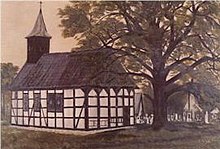Oppenweher Klus
The Oppenweher Klus was or is a small half-timbered - Chapel in Stemweder district Oppenwehe .
history
The Oppenweher Klus is first mentioned in the 13th century, which stood in the "Klusgarten", which belonged to the Colon (farmer) Rohlfing; by then it was probably a few centuries old. Before the Reformation the provost had to preach to Levern in the little clus; Over time, the number of services decreased to just seven times a year: On the Sunday after the birth of Mary (September 8th) and on the six Wednesdays during Lent , the provost had to go to the Oppenweher Klus and preach. The service at the beginning of September was followed by a procession that was connected to a fair that stretched as far as the Alte Postweg. Visitors mostly came from neighboring towns, such as Prussian Ströhen and Wagenfeld . The Oppenweher market (the fair) is held to this day. Like the Oppenweher, the Wagenfeld was parish off to Wehdem and so they too attended the service in the Klus; they even had their own entrance, the so-called "Wagenfeld door".
In 1699 the Klus was rebuilt; the previous building was probably demolished because it had become too small for the Oppenweher. The Klus had its own altar , a baptismal font and a sacrificial urn. There was also a pulpit with a sound cover and a carved wooden dove hanging loosely underneath, the symbol of the Holy Spirit. The Klus also had four stained glass windows showing John , Paul , Peter, and Jacob . The Klus was 13.52 m high, 5.14 m wide and 11.30 m long.
In 1753, Pastor Gottfried Schlichthaber wrote in the church chronicle of Mindeschen Kirchengeschichte: “The Klus stood in the garden of Colon Rohlfing No. 2.” This place is still called the Klusgarten today. The chapel stood in a consecrated place. The name of the place Oppenwehes should be traced back to this: “Op den Weihden” means “on the consecrated place”.
In 1808 the first Oppenweher cemetery was established on the Klus and the then very old and expansive cemetery linden tree. At the end of the 19th century the chapel building gradually fell into disrepair and its use for church services had to be severely restricted. A collection of donations carried out on January 2, 1900 for the construction of a new chapel in Oppenwehe brought in 407 marks, a very considerable sum of money for the time. In 1919 an additional pastor's office was set up for Oppenwehe in the parish of Wehdem, and in autumn 1922 a separate rectory was built about four kilometers from the Klus; later Oppenwehe broke away completely from the parish of Wehdem. In the spring of 1930 the decision was made to “build a new chapel” and after several requests and great willingness to sacrifice the congregation, the consistory in Münster granted permission to build a church in Oppenwehe on October 29 of the same year. Thus the days of the old clusters were numbered and on November 5, 1930 it was decided to demolish them. The church master in Oppenweher advocated the construction of a church on the “Vahrenkamp” and a new building at the old location was prevented. On November 9, 1930, the foundation stone for the new church was laid and celebrated with a big party, while the small clump was quietly torn down without any sympathy. The bell that hung in the tower of the old Klus, as well as the four stained glass windows, passed into their possession when the new "Martini Church" was inaugurated on July 26, 1931 - the windows found their new place in the sacristy, the bell in the tower the church. During the Second World War, however, the bells of the Martini Church were forcibly melted down, as were those of the old Klus.
On Eternal Sunday in 1950, the old location of the Klus as a church area was completely lost; the cemetery had become too small and was relocated near the new church.
Replica
In 2003 Oppenwehe celebrated its 775th anniversary of the first mention, which was celebrated on September 14th of that year with a large parade and over 30,000 visitors. On this occasion, the Oppenweher Klus was recreated on a 1: 2 scale by the citizens of Oppenwehes; the artist Claudia Hassebrock created the lead glazing for the eight new windows. The cross of the tower was hand- cast by the Heinrich Meier foundry in Rahden . It is labeled on both sides; "775 years of Oppenwehe" is written on the front and "Alte Klus" is written on the back. The new Oppenweher Klus became the absolute highlight of the parade.
On April 26, 2004 around 20 Oppenweher founded the association “Oppenweher Klus e. V. ", who has set himself the task of" building, maintaining and maintaining a true-to-scale replica of the 'Alte Oppenweher Klus' with appropriate facilities ".
The true-to-scale replica was then set up on June 15, 2004 at the location of the old Oppenweher Klus. On August 7, 2005, the first service took place at the new Klus, even three baptisms took place with the help of the preserved original baptismal font. The old, preserved altarpiece, which was created in 1830 by the Minden painter Schirmer, was restored and placed in the new Klus. The new Klus is 6.76 m high, 2.57 m wide and 5.65 m long.
Over time, the new Oppenweher Klus has become the new landmark of Oppenwehe.
Web links
Coordinates: 52 ° 27 ′ 51.2 " N , 8 ° 30 ′ 25.4" E


